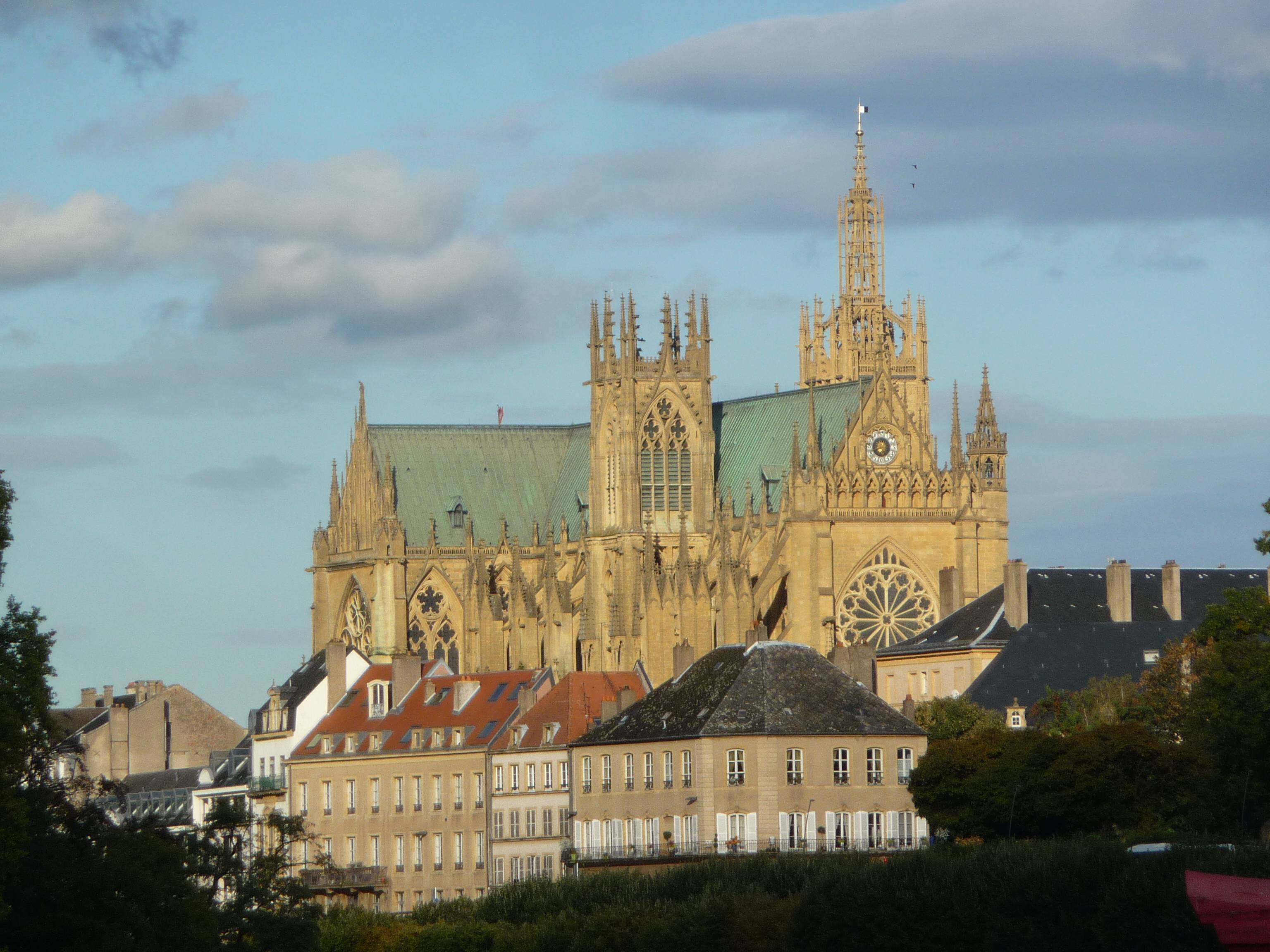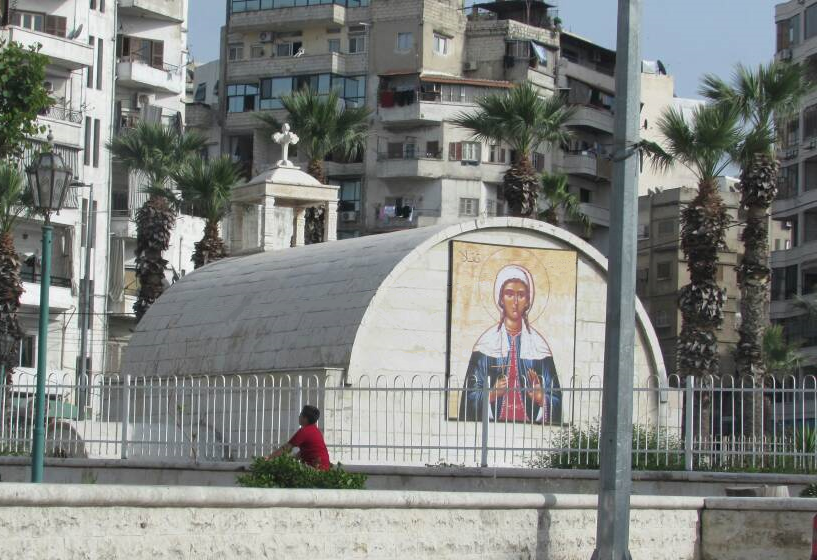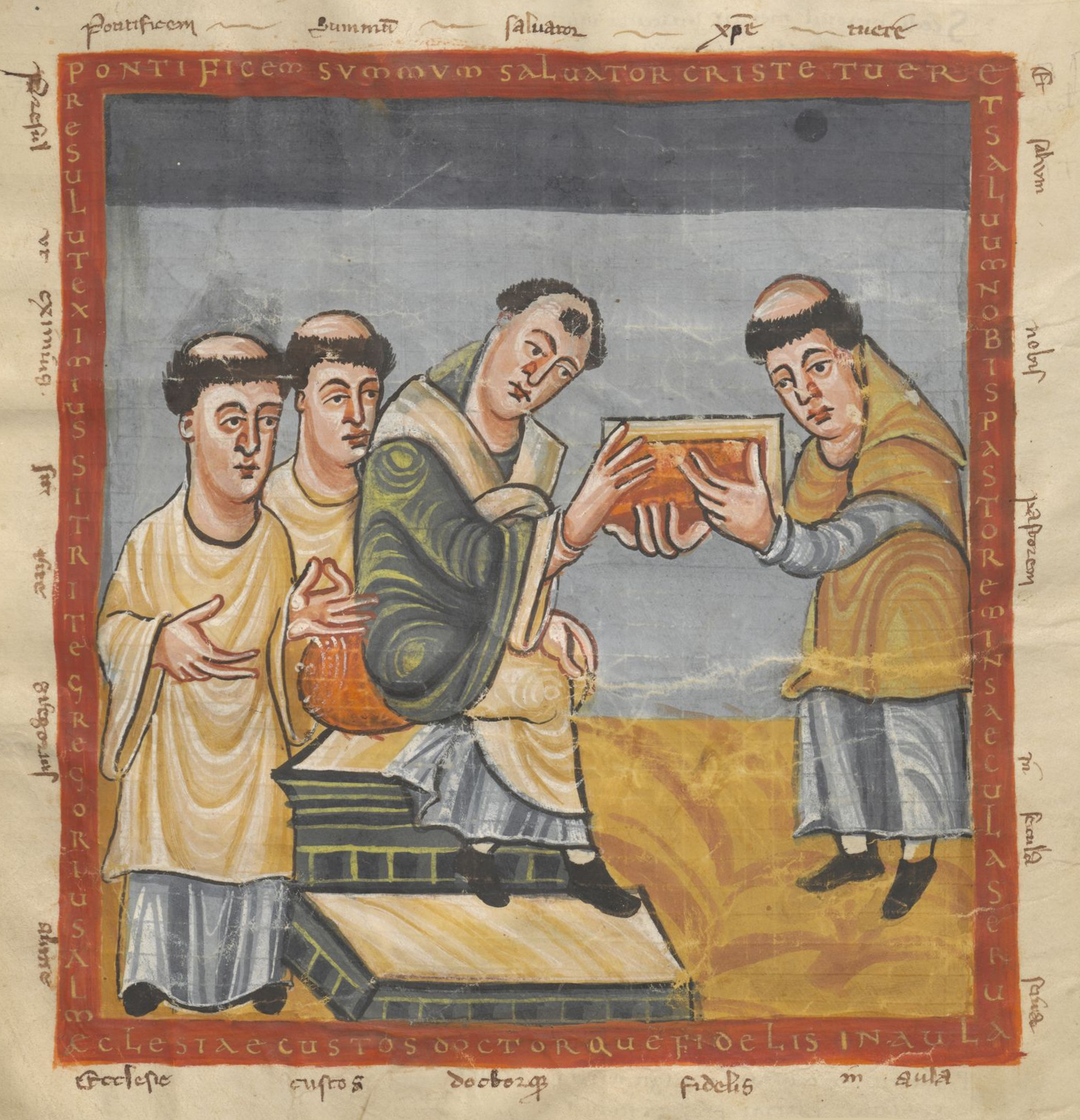|
Glodesind
Glodesind (572−608) was a saint, nun, abbess, and founder of a convent in Metz, France, during the time of King Childebert II (575−596) of Austrasia. She was a member of the Carolingian nobility. When she was 11 or 12 years old, she married a young nobleman, who was arrested by the French government shortly after their wedding and executed a year later. Instead of remarrying as her family wanted, she fled to Metz and took refuge at the Church of St. Stephen. Her family gave up forcing her to marry, and she became a nun and later, the abbess of a convent that was built by her parents. She was abbess for six years until her death in 608 at the age of 30. Her feast day is 8 July. The miracles that established her sainthood did not begin to occur until 25 years after her death, after the first time her body was reinterred. Glodesind was initially interred on the grounds of a church dedicated to Saint Arnulf, but was moved two more times; the final time at a cemetery built on ... [...More Info...] [...Related Items...] OR: [Wikipedia] [Google] [Baidu] |
Arnulf Of Metz
Arnulf of Metz ( 582 – 645) was a Frankish bishop of Metz and advisor to the Merovingian court of Austrasia. He later retired to the Abbey of Remiremont. In French he is also known as Arnoul or Arnoulf. In English he is known as Arnold. Genealogy The ''Vita Sancti Arnulfi'', written shortly after the saint's death, states that he was of Frankish ancestry, from "sufficiently elevated and noble parentage, and very rich in worldly goods". Sometime after 800, most likely in Metz, a brief genealogy of the Carolingians was compiled. According to this source, Arnulf's father was a certain Arnoald, also a bishop of Metz who in turn was the son of Ansbertus and Blithilt (or Blithilde), an alleged and otherwise unattested daughter of Chlothar I. This claim of royal Merovingian descent is not confirmed by the contemporary reference in the ''Vita''. Under Salic law no children of Blithilde would be recognized as legitimate heirs to the dynasty, so an event like this would hardly b ... [...More Info...] [...Related Items...] OR: [Wikipedia] [Google] [Baidu] |
Metz, France
Metz ( , , lat, Divodurum Mediomatricorum, then ) is a city in northeast France located at the confluence of the Moselle (river), Moselle and the Seille (Moselle), Seille rivers. Metz is the Prefectures in France, prefecture of the Moselle (department), Moselle Departments of France, department and the seat of the parliament of the Grand Est Regions of France, region. Located near the Tri-border area, tripoint along the junction of France, Germany and Luxembourg,Says J.M. (2010) La Moselle, une rivière européenne. Eds. Serpenoise. the city forms a central place of the European Greater Region and the SaarLorLux euroregion. Metz has a rich 3,000-year history,Bour R. (2007) Histoire de Metz, nouvelle édition. Eds. Serpenoise. having variously been a Celts, Celtic ''oppidum'', an important Gallo-Roman city,Vigneron B. (1986) Metz antique: Divodurum Mediomatricorum. Eds. Maisonneuve. the Merovingian capital of Austrasia,Huguenin A. (2011) Histoire du royaume mérovingien d' ... [...More Info...] [...Related Items...] OR: [Wikipedia] [Google] [Baidu] |
Trier
Trier ( , ; lb, Tréier ), formerly known in English as Trèves ( ;) and Triers (see also names in other languages), is a city on the banks of the Moselle in Germany. It lies in a valley between low vine-covered hills of red sandstone in the west of the state of Rhineland-Palatinate, near the border with Luxembourg and within the important Moselle wine region. Founded by the Celts in the late 4th century BC as ''Treuorum'' and conquered 300 years later by the Romans, who renamed it ''Augusta Treverorum'' ("The City of Augustus among the Treveri"), Trier is considered Germany's oldest city. It is also the oldest seat of a bishop north of the Alps. Trier was one of the four capitals of the Roman Empire during the Tetrarchy period in the late 3rd and early 4th centuries. In the Middle Ages, the archbishop-elector of Trier was an important prince of the Church who controlled land from the French border to the Rhine. The archbishop-elector of Trier also had great signific ... [...More Info...] [...Related Items...] OR: [Wikipedia] [Google] [Baidu] |
7th-century Frankish Saints
The 7th century is the period from 601 ( DCI) through 700 ( DCC) in accordance with the Julian calendar in the Common Era. The spread of Islam and the Muslim conquests began with the unification of Arabia by Muhammad starting in 622. After Muhammad's death in 632, Islam expanded beyond the Arabian Peninsula under the Rashidun Caliphate (632–661) and the Umayyad Caliphate (661–750). The Muslim conquest of Persia in the 7th century led to the downfall of the Sasanian Empire. Also conquered during the 7th century were Syria, Palestine, Armenia, Egypt, and North Africa. The Byzantine Empire suffered setbacks during the rapid expansion of the Caliphate, a mass incursion of Slavs in the Balkans which reduced its territorial limits. The decisive victory at the Siege of Constantinople in the 670s led the empire to retain Asia Minor which assured the existence of the empire. In the Iberian Peninsula, the 7th century was known as the ''Siglo de Concilios'' (century of councils) refe ... [...More Info...] [...Related Items...] OR: [Wikipedia] [Google] [Baidu] |
608 Deaths
6 (six) is the natural number following 5 and preceding 7. It is a composite number and the smallest perfect number. In mathematics Six is the smallest positive integer which is neither a square number nor a prime number; it is the second smallest composite number, behind 4; its proper divisors are , and . Since 6 equals the sum of its proper divisors, it is a perfect number; 6 is the smallest of the perfect numbers. It is also the smallest Granville number, or \mathcal-perfect number. As a perfect number: *6 is related to the Mersenne prime 3, since . (The next perfect number is 28.) *6 is the only even perfect number that is not the sum of successive odd cubes. *6 is the root of the 6-aliquot tree, and is itself the aliquot sum of only one other number; the square number, . Six is the only number that is both the sum and the product of three consecutive positive numbers. Unrelated to 6's being a perfect number, a Golomb ruler of length 6 is a "perfect ruler". Six is a con ... [...More Info...] [...Related Items...] OR: [Wikipedia] [Google] [Baidu] |
572 Births , a semi-automatic pistol
{{Numberdis ...
57 may refer to: * 57 (number) * one of the years 57 BC, AD 57, 1957, 2057 * "57" (song), a song by Biffy Clyro * "Fifty Seven", a song by Karma to Burn from the album ''Arch Stanton'', 2014 * "57" (album), a studio album by Klaus Major Heuser Band in 2014 * "57 Live" (album), a live double-album by Klaus Major Heuser Band in 2015 * Heinz 57 (varieties), a former advertising slogan * Maybach 57, a car * American Base Hospital No. 57 * Swift Current 57's, baseball team in the Western Canadian Baseball League * FN Five-Seven The FN Five-seven (stylized as Five-seveN) is a semi-automatic pistol designed and manufactured by FN Herstal in Belgium. The pistol is named for its 5.7×28mm (.224 in) bullet diameter, and the trademark capitalization style is intended to ... [...More Info...] [...Related Items...] OR: [Wikipedia] [Google] [Baidu] |
Thecla
Thecla ( grc, Θέκλα, ) was a saint of the early Christian Church, and a reported follower of Paul the Apostle. The earliest record of her life comes from the ancient apocryphal ''Acts of Paul and Thecla''. Church tradition The ''Acts of Paul and Thecla'' is a 2nd-century text () which forms part of the ''Acts of Paul'', but was also circulated separately. According to the text, Thecla was a young noble virgin from Iconium who listened to Paul's "discourse on virginity", espoused his teachings and became estranged from both her fiancé, Thamyris, and her mother. Thecla sat by her window for three days, listening to Paul and his teachings. When her mother and fiancé witnessed this, they became concerned that Thecla would follow Paul's demand that "one must fear only one God and live in chastity", and turned to the authorities to punish both Paul and Thecla. Thecla was miraculously saved from burning at the stake by the onset of a storm and traveled with Paul to Antioch o ... [...More Info...] [...Related Items...] OR: [Wikipedia] [Google] [Baidu] |
Seille (Moselle)
The Seille (; german: Selle) is a river in north-eastern France. It is a right tributary of the Moselle. It is also known as the ''Seille lorraine'' or the ''Grande Seille'' ("large Seille"), to distinguish it from another Seille, a small tributary of the Saône. It originates near Azoudange, in the department of Moselle. Leaving the Lindre lake, it skirts the town of Dieuze, and traverses Vic-sur-Seille and Nomeny, before flowing into the Moselle at Metz. It is 138 km long, and has a basin area of 1348 km2. Most of its length is in the department of Moselle, except for the part between Aulnois-sur-Seille and Cheminot, which is in Meurthe-et-Moselle. The Seille also forms the border between Moselle and Meurthe-et-Moselle from Chambrey to Aulnois-sur-Seille. Upstream Originating in the Pond region, the Seille then crosses the Saulnois, a region in the south of Moselle. This section of the river is part of the ''Parc naturel régional de Lorraine'' ("Regional Na ... [...More Info...] [...Related Items...] OR: [Wikipedia] [Google] [Baidu] |
Pilgrim
A pilgrim (from the Latin ''peregrinus'') is a traveler (literally one who has come from afar) who is on Pilgrimage, a journey to a holy place. Typically, this is a physical journey (often on foot) to some place of special significance to the adherent of a particular religious belief system. In the spiritual literature of Christianity, the concept of pilgrim and pilgrimage may refer to the experience of life in World (theology), the world (considered as a period of exile) or to the inner path of the spiritual aspirant from a state of wretchedness to a state of beatitude. History Pilgrims and the making of pilgrimages are common in many religions, including the faiths of ancient Egypt, Persia in the Mithraism, Mithraic period, India, China, and Japan. The ancient Greece, Greek and Ancient Rome, Roman customs of consulting the Deity, gods at local oracles, such as those at Dodona or Delphi, both in Greece, are widely known. In Greece, pilgrimages could either be personal or state ... [...More Info...] [...Related Items...] OR: [Wikipedia] [Google] [Baidu] |
Sulpicius Severus
Sulpicius Severus (; c. 363 – c. 425) was a Christian writer and native of Aquitania in modern-day France. He is known for his chronicle of sacred history, as well as his biography of Saint Martin of Tours. Life Almost all that we know of Severus' life comes from a few allusions in his own writings, some passages in the letters of his friend Paulinus, bishop of Nola, and a short biography by the historian Gennadius of Massilia. Born of noble parents in Aquitaine, Severus enjoyed excellent educational advantages. He was imbued with the culture of his time and of his country, a centre of Latin letters and learning. He studied jurisprudence in Burdigala (Modern Bordeaux) and was renowned as an eloquent lawyer; his knowledge of Roman law is reflected in parts of his writings. He married the daughter of a wealthy consular family, who died young, leaving him no children. At this time Severus came under the powerful influence of Saint Martin, bishop of Tours, by whom he was led t ... [...More Info...] [...Related Items...] OR: [Wikipedia] [Google] [Baidu] |
Saint Peter
Saint Peter; he, שמעון בר יונה, Šimʿōn bar Yōnāh; ar, سِمعَان بُطرُس, translit=Simʿa̅n Buṭrus; grc-gre, Πέτρος, Petros; cop, Ⲡⲉⲧⲣⲟⲥ, Petros; lat, Petrus; ar, شمعون الصفـا, Sham'un al-Safa, Simon the Pure.; tr, Aziz Petrus (died between AD 64 and 68), also known as Peter the Apostle, Peter the Rock, Simon Peter, Simeon, Simon, or Cephas, was one of the Twelve Apostles of Jesus Christ, and one of the first leaders of the Jewish Christian#Jerusalem ekklēsia, early Christian Church. He is traditionally counted as the first bishop of Romeor List of popes, popeand also as the first bishop of Antioch. Based on contemporary historical data, his papacy is estimated to have spanned from AD 30 to his death, which would make him the longest-reigning pope, at anywhere from 34 to 38 years; however, the length of his reign has never been verified. According to Apostolic Age, Christian tradition, Peter was crucified in Rome und ... [...More Info...] [...Related Items...] OR: [Wikipedia] [Google] [Baidu] |
Pope Gregory IV
Pope Gregory IV ( la, Gregorius IV; died 25 January 844) was the bishop of Rome and ruler of the Papal States from October 827 to his death. His pontificate was notable for the papacy’s attempts to intervene in the quarrels between Emperor Louis the Pious and his sons. It also saw the breakup of the Carolingian Empire in 843. Rise to papacy The son of a Roman patrician called John, Gregory was apparently an energetic but mild churchman, renowned for his learning. Consecrated a priest during the pontificate of Pope Paschal I, at the time of Pope Valentine’s death in 827, Gregory was the cardinal priest of the Basilica of St Mark in Rome. Like his predecessor, Gregory was nominated by the nobility, and the electors unanimously agreed that he was the most worthy to become the bishop of Rome. They found him at the Basilica of Saints Cosmas and Damian where, despite his protestations, he was taken and installed at the Lateran Palace, after which he was enthroned as pope-elect so ... [...More Info...] [...Related Items...] OR: [Wikipedia] [Google] [Baidu] |









